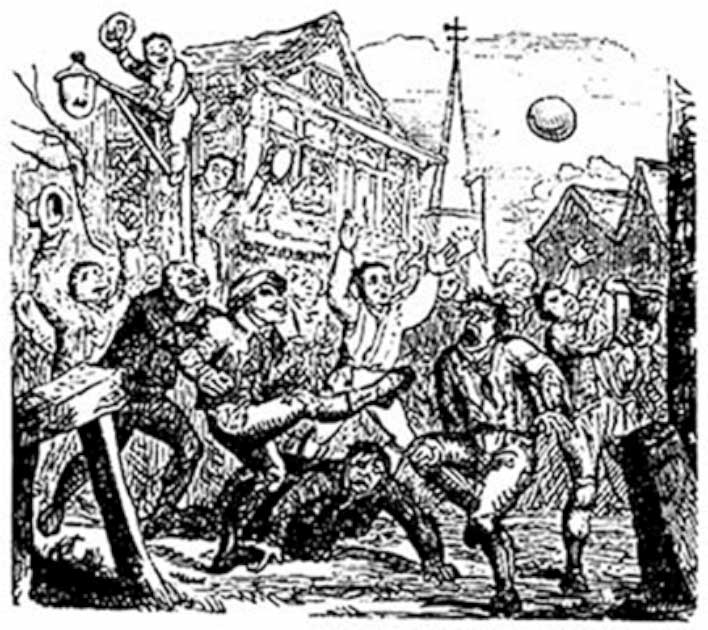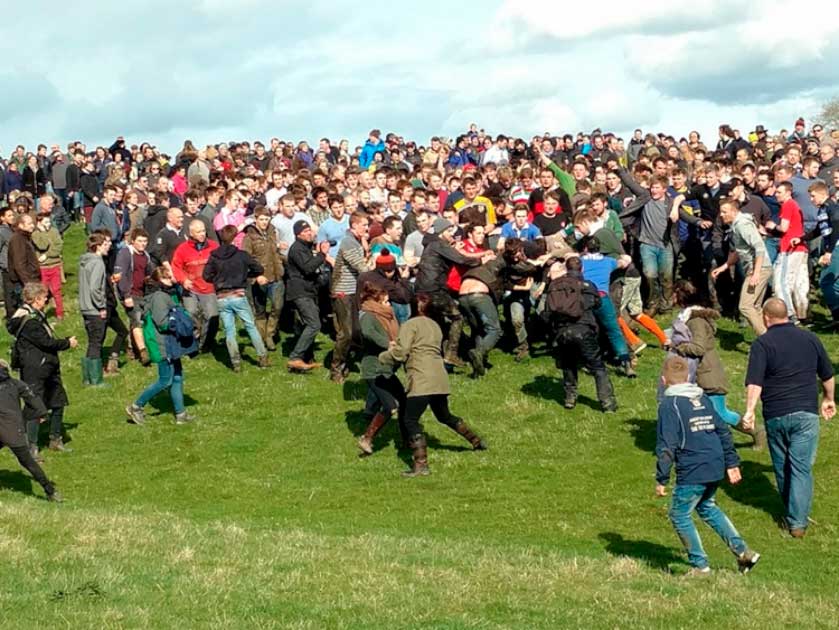Football! The beautiful game, far more important than life and death to millions of people the world over, is engrained into the psyche of the human race. The origins of football (or soccer, if you must) however, show that the path to its current world dominance was not a smooth one.
In fact, there have even been times where football was banned. To know the reason behind the banning of medieval football, you need to understand its origin. It is quite tricky to trace the origin of football, and we must sift through history to find what small clues we can.
In the 9th century, a group of young men playing with a ball was observed and recorded by a Welsh monk named Nennius. 300 years later in the year 1147, the payment for “7 balloons of the greatest dimension” was recorded by a charter in Normandy, to be used for the “La Soule” games.
In this famous match up, two parishes challenged each other’s parish church to get a ball across the countryside. The “la soule” ball was considered to be very hard as it was made up of leather stuffed with hay or wood.
In the late 9th century, the Shrove Tuesday festivities in London were observed and recorded by William Fitzstephen. It has been observed that all the youth of the city had finished their launch and took part in a ball game. Even each city worker was carrying their balls as well as each school’s students were holding their own balls.
Medieval Football
This seems to have been the norm for medieval football: a the ball game pitting one village against another village, or otherwise played amongst a community. The players of this football game would set the goal or a target to get the ball.

At that time, no specific rules had been observed relating to medieval football; if observed, then those rules were likely often ignored in the emerging fracas. Even the numbers of players was unlimited.
Although there is evidence that the player can use sticks and their hand to move the ball toward its destination was also acceptable, kicking the football was an integral aspect of the game. These contests were frequently risky and may resemble large brawls.
- Wyoming Prison Baseball: The Inmates who Played for their Lives?
- The Great Chess Automaton: Did A “Thinking Machine” Really Play Chess?
At Ulgham in Northumberland, a football game was organized in 1280 that resulted in a fatality after one ball player stabbed an opponent with a dagger. Later, some Cornishmen indulged in the la soule game by following the continental tradition in 1283, where a man named Roger was stuck by the stone ball on the head and killed.
Further, students from Oxford University took part in the ball game in 1303, where one of the students named Adam was found dead. It was alleged that Irish students killed him while playing medieval football in the High Street towards Eastgate.
In the year 1321, a papal dispensation was issued to William, a canon of Scoldham, to excuse him for an accident which occurred in the match. William’s team rushed towards him as he was kicking the ball during the game, and the wave of players clashed with the other team. William was carrying a concealed dagger and he sustained a severe wound in the crush, which caused a man to pass away within six days.

Dispensation is granted because William de Spalding, who requested it from the pope out of intense sorrow over his friend’s passing and dread of what his enemies may say, bears no responsibility. As many incidents happened because of playing medieval football, it was considered to be dangerous for the participants in the game.
Banning Football
None of this could dampen the enthusiasm for this sport, and as the popularity of this dangerous game began to grow, the authorities became concerned about the uncounted injuries and incidents as well as the fatalities. With King Edward II’s support, the Lord Mayor of London enacted a ban on medieval football activity in the year 1314.
The edict read: “We forbid and command on behalf of the king, on pain of imprisonment, the football game to being used in the future.” Following his lead, the game of la soule was banned in 1331 by King Philip VI of France.
Further, King Edward III put a stop to all forms of gaming in England in 1363 by saying, “We ordain that you forbid under the imprisonment penalty all and everybody from such wood, iron, and stone-throwing; football, handball, or hockey; cock-fighting and coursing, or other such useless diversions.”
This may have been an attempt by Edward to divert his peasants towards more militarily useful pastimes, as just two years later Edward would pass the Archery Law, which forbade any pastime that interfered with Englishmen’s Sunday bow practice. It seems that, if you must do something fun in your free time, the king wanted it to be of benefit to him.
In the following century, France and England were joined by Scotland when a statue was issued by King James I that stated “no man would play fute-ball under the fifty schillings pain until they are trained”. Moreover, the last provisions suggest that the desire of the king to criminalize football was not shared by the nobility.
Does Anyone Play Medieval Football Today?
Amazingly, there are still places where the medieval football game is played as a part of the celebrations for Shrove Tuesday. At Alnwick Castle in Northumberland, the scoring of the Hales game began with the dropping of the ball over the side of the castle walls.

Two rival English parishes, St Paul’s and St Michael’s, still engage in a 150-a-side ball game where the winner is the first to score two goals. Apart from that, there are other surviving games of medieval football that include Ashbourne in Derbyshire, a Firemen v Fishermen game in Scarborough’s South Bay beach, Corfe Castle in Dorset, and Workington in Cumbria.
The medieval football game still exists in Scotland as well, which is played around New Year and Christmas in Scone, Kirkwall in Orkney, Jedburgh, and many other places. Apart from these, a strong similarity to medieval football in Europe is shared by some other regions outside Europe, such as Ki-o-rahi in New Zealand, Kemari in Japan, Cuju in China, and Marn Grook in Australia.
If you look into the long-term perspective, then the efforts to ban medieval football failed in France, Scotland, and England. Presently, the sport is well known to many people and is hugely organized, codified, and restricted to 11 members of a team.
It has been identified that the root of the football game depends on the mass participation of players in a dangerous game. Nowadays, players are prohibited from wearing daggers, and the ball is filled with air rather than hay, the better to save your feet as you score a scorching 40-yard belter that sends the keeper the wrong way.
There have been modern attempts to ban football as well, however In the year 1921, women’s football was banned by the FA in England, stating that the football game was not suitable for women and should not be encouraged.
In 1971, the ban was lifted from women’s football with the Women’s Super League beibg introduced in England as late as 2011. In 2018, this game turned professional for women. Overall, it can be said that for over 700 years, people have been banning football games, but they were never able to do it successfully.
Top Image: Medieval football was considered dangerous and a distraction for the populace. What was it that made it so dangerous it was banned? Source: Lustre / Adobe Stock.
By Bipin Dimri